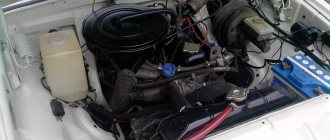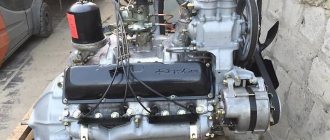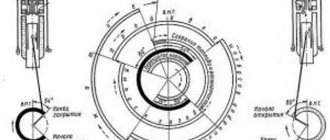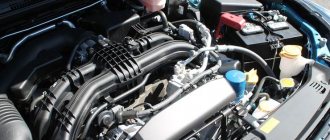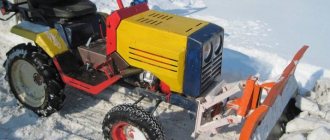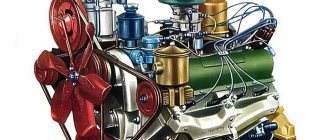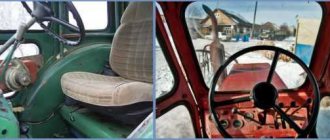One of the most legendary engines of the Soviet Union remains the ZMZ 402 engine (abbreviated as dv. 402). The manufacturer of the power unit is Zavolzhsky Motor Plant LLC, which is where the engine got its name - ZMZ 402. Another modification was the ZMZ 24D, but it did not catch on due to frequent repairs and expensive maintenance.
Story
It was developed by no less legendary designer Harry Voldemarovich Evart specifically for the Volga. This power unit was supposed to replace the outdated GAZ-21 engine. In subsequent development, many modifications were made, such as ZMZ-24D and ZMZ 4021.
This engine is also called ZMZ 24, since it was initially intended to be installed only on the 24th Volga, but as practice and history have shown, the engine has become quite widespread in other car models.
The ZMZ 24D engine had improved cooling characteristics, which reduced fuel consumption. But this series of engines was interrupted in 1972, because repairs to the power unit were too expensive.
Subsequently, VOLGA received only two power units - ZMZ 402 and ZMZ 402.1. But, as practice shows, the use of ZMZ 24 and ZMZ 24D power units has reached our time, and such engines can still be found on some 24-series cars.
Starter
With the help of a starter, the engine starts, and how well it works determines whether the car will drive or not. For 3110 motors, starters are produced by many manufacturers, and they also vary in power.
This is what a starter for a Volga 3110 car looks like
For ZMZ 402, there are many types of engine starting devices in terms of power, but they are mainly divided into large and small. A small starter has an average power of about 1 kW, a large one - from 1.5 to 1.8 kW. There are also quite a lot of different manufacturers. The most famous are starters of the brands BATE (Republic of Belarus), KATEK, LKD, FENOX, PRAMO, ZMZ KENO.
Specifications and description
The Volgov engine was considered one of the most reliable in the Union. Despite the high consumption, the 402 engine was loved by many motorists. So, let's look at the main characteristics of the ZMZ 402 engine, as well as how it works:
| Name | Characteristic |
| Manufacturer | ZMZ |
| Model | ZMZ 24, ZMZ 24D |
| Modifications | ZMZ 4021, ZMZ 4022, ZMZ 4025, ZMZ 24S |
| Motor type | Petrol |
| Injection type | Carburetor |
| Configuration | 4-cylinder in-line longitudinal internal combustion engine |
| Engine power | 95 hp |
| Number of cylinders | 4 |
| Number of valves | 8 |
| Piston diameter | 92 mm |
| Piston stroke | 92 mm |
| Cooling | Liquid |
| Block and head material | Aluminum |
| Resource | 300,000 km |
| Cylinder operating order | 1-2-4-3 |
| Ignition system | Contact or non-contact |
Adjusting the ignition timing of the ZMZ-402 engine
The ZMZ0-402 type engine is equipped with an ignition distributor sensor (1908.3706) - non-contact, with a control pulse sensor (generator) and built-in vacuum and centrifugal ignition timing regulators.
The distribution sensor performs two functions: it sets the moment of sparking and distributes high voltage pulses among the cylinders in accordance with the order of their operation. For this purpose, a slider mounted on the shaft of the sensor-distributor is used.
A noise suppression resistor is installed in the slider.
Technical characteristics of the ignition system
Motor applicability
As already mentioned, the ZMZ 402 engine can be installed not only on the Volga passenger car, but also on a number of similar vehicles. Quite widely the ZMZ 402 was installed on UAZ. You can often find a UAZ 469 with a Volga engine. In this case, the motor was installed on the car from the manufacturer's factory. This was due to the fact that during the transition from the outdated internal combustion engine UMZ 417 to UMZ 421.
At this moment, the UAZ engine was going through hard times and the plant management decided to temporarily replace the Ulyanovsk engines with similar ones from the Zavolzhsky plant. As practice and operation have shown, the UAZ 402 was able to withstand all the required loads. But, with the release of the Ulyanovsk 421 engine, everything changed radically, and it was decided to abandon the use of ZMZ.
Another prominent representative that received these power units was Gazelle. On the first models of the light-duty GAZ truck, you can find the ZMZ 24 engine. Later, with the development and implementation of factory innovations, the 4021 engine was installed. The Gazelle with the ZMZ 402 engine was produced for quite a long time until the manufacturer began to introduce the 405 and 406 power units.
With the advent of new engine types, the situation at the GAZ plant did not change radically and the Gazelle with the 402 engine was produced before 1997. But, after replacing the body with a new model, GAZ management nevertheless decided to install only 405 and 406 engines, as well as their modifications, on new cars. Thus, the era of using the Gazelle car with the ZMZ 402 power unit has ended.
Electrical equipment GAZ 3110
As in any car, the GAZ 3110 electrical circuit contains automotive wiring with connectors, various relays and sensors, fuses, instruments, as well as energy sources and consumers. Energy sources are a generator and a battery; consumers include:
Starter design diagram for Gas 3110
- Heater and windshield wiper motors;
- Sound signals;
- Lighting devices;
- Ignition system elements;
- Radio, alarm, as well as other consumers installed by the user.
The Volga 3110 has an electronic speedometer. It should be noted that on the previous GAZ 31029 model the speedometer was equipped with a mechanical drive (cable). Also, unlike the 31029, the 3110 model now has a tachometer.
But the new device cannot immediately work on a GAZ car without problems, and therefore various problems arose with the speedometer and tachometer.
The tachometer in the first models had the following flaw - the instrument needle trembled, indicating the number of revolutions. Later, the manufacturer brought the device to perfection, and the owners of the first cars had to fix the defects with their own hands - solder an additional resistor into the tachometer circuit.
Tachometer from Volga 3110
After 1999 this problem disappeared on cars. It also needs to be said that there were different ones - they were produced in Vladimir and Riga.
Tuning
Modifying the ZMZ 402 engine with your own hands is quite simple. Of course, many car enthusiasts who practice tuning the ZMZ 402 engine try to first change the injection system from a carburetor to a monoinjector, but in classic tuning the existing characteristics are refined. In this section we will look at what tuning can be applied to the 402 engine.
The first thing to be modified is the piston group. So, instead of a standard piston kit, a lightweight ATF from a Polish manufacturer is installed. In the same way, it is worth replacing the valves and connecting rods with lighter ones. By reducing the weight of the power unit, torque increases and engine power increases.
The next step is to groove the crankshaft and install sports-type liners. Thus, you can further reduce the weight of the motor, which will allow you to gain speed faster.
A separate stage is the modification of the injection and exhaust system. Instead of native manifolds, you can install Hungarian ones from the DDR-line company, which are designed specifically for tuning the ZMZ 402 engine and its modifications. Instead of the original K-126 carburetor, motorists usually install a monoinjector or a Zhiguli ODAZ from a VAZ 2107. This significantly reduces fuel consumption by a couple of liters. For improved air supply to the combustion chamber, a zero-resistance air filter is installed.
An integral part of the process is the modification of the ignition. So, many people know that there is contact and non-contact ignition, but the third ignition option is to install a start using a button, which does not require a key. This ignition system has become quite common when upgrading a given internal combustion engine.
In addition to the system itself, spark plugs, wires and the ignition coil are also changed. The most common company that produces tuning kits is BRW and VHI. The first is Belarus, but the second is Russia.
The tuning of the 402 engine does not end there. Also, motorists are changing the cooling system. To do this, a more advanced and lightweight aluminum radiator, pump and silicone pipes are installed instead of the standard ones. This allows for an improved cooling system that works more efficiently at high speeds and prevents the power unit from overheating.
Communities › GAZ Volga › Blog › Correct ignition adjustment of ZMZ 402.
Hi all ! I needed to set the ignition to 402. On the Internet, everyone writes differently! 1 Please tell me, STEP BY STEP! how to set the ignition correctly on 402? (electronic ignition, conventional) I will display it on the street near the house. 2 Does the distributor slider rotate clockwise or counterclockwise? 3 Trying to start the car, it turns, but does not start, and after releasing the ignition key, the crankshaft turns in the opposite direction. (late ignition?) So I decided to set the ignition again from scratch! PLEASE TELL US HOW TO DO IT WITHOUT MUCH WORRY. As soon as I start the car, I will adjust it using the strobe light.
TODAY I SET THE IGNITION! THE CAR STARTED WITH ALMOST HALF A KICK! BUT there is a question: when the slider is on the first cylinder, unscrew the rear bolt and align the marks on the distributor under the slider, BUT! the slider has free movement, I turned it clockwise all the way and aligned the marks. DID I DO IT RIGHT? OR maybe you need to turn it counterclockwise all the way?
P.S. I still have to buy a new carburetor!
Maintenance
How to properly maintain your Volgov engine? It is very rare to find reliable information on the Internet about the maintenance of the ZMZ 402. In turn, technical maps from the manufacturer’s plant on proper maintenance of the motor were found. So, let’s describe how to carry out maintenance for 24:
- 1000 km: oil and oil filter change.
- 8000 km: changing oil, oil and air filters, spark plugs, high-voltage wires, fine fuel filter.
- 17,000 km: oil change, oil filter, fuel filter.
- 25,000 km: changing oil, oil and air filters, spark plugs, high-voltage wires, fine fuel filter, valve adjustment.
- 35,000 km: oil change, oil filter, fuel filter, timing belt and alternator replacement.
- 45,000 km and beyond: change the oil and oil filter. Every 20,000 km the fuel and air filters are changed and the valves are adjusted. Every 40,000 km, replace the timing belt.
Ignition system elements
One of the main systems necessary for a successful engine start is the ignition system. For gasoline engines, the fundamental design of ignition systems differs very slightly - there are two types: • Contact system • Contactless system
The ignition system consists of the following components: 1. Coil 2. Distributor-spark breaker (distributor) 3. Switch 4. Spark plugs 5. Ignition switch 6. Starter 7. Additional resistance (in some cases)
Repairs and main problems
The ZMZ 402 engine and its modifications are quite easy to repair even in the worst technical condition. Thus, the power unit, the block head and the replacement of consumables are being overhauled. The repair process itself is carried out in stages, as for any power unit. So, let's consider the step-by-step process of overhaul of ZMZ 402.
Disassembly
At this stage, the internal combustion engine is completely disassembled, namely, the block head is dismantled, the pan is removed and all parts are disassembled. For this type of motor, the troubleshooting process is carried out during disassembly. This does not include only measurements of the cylinder block, pressure testing of the head, and also measurements of the crankshaft.
Diagnostic operations
At this stage, work is being carried out to determine the hardness and thickness of the crankshaft journals, as well as its maintainability. So, if the part can be repaired, then the size of the necks is determined and the product is sent for further processing. The same thing awaits the cylinder block. The liners are measured and the repair size of the pistons is determined.
Pressure testing of the ZMZ 402 cylinder head is a process of determining the presence of cracks in the housing. All holes on the head are closed except for the coolant inlet, into which hot water or kerosene is supplied. Next, the specialist looks for leaks and cracks. If not, then the cylinder head is sent for repair, and if there is, then all defects must be welded.
Since the part is made of aluminum, argon welding is used. In garage conditions, motorists use cold welding to seal holes in the power unit housing.
Boring
The cylinder block and crankshaft are bored. If the cylinders are already out of repair size, then liners with a standard diameter of 92 mm are installed. For a cylinder block, honing becomes characteristic - this is one of the processes of boring the cylinders of a block using a special machine. The crankshaft is bored on a special unit, using high speeds and a stone that polishes the journals.
Work on cylinder head
The cylinder head can also be rebuilt. Thus, valves, seats, seals and cuffs are often changed. Many times, specialists have to replace valve guides. With the development of modern repair technology, for ZMZ 402 it is possible to use a sleeve using k-line technology. For this purpose, bronze bushings measuring 9 mm are used.
Today, replacing the camshaft is quite common. This is due to the fact that the engines are 20-30 years old and this part has already worn out several times. Therefore, when repairing the cylinder head, you should pay special attention to this part. If necessary, the working surface of the block head is ground.
Assembly
Assembly operations are carried out on a special stand. All parts are installed in the same sequence as they were disassembled. So, often the oil and water pumps can be replaced, and a new set of gaskets is installed.
Tool for the job
The work of adjusting valve clearances requires preparation. Place tools and materials for measurements in a convenient position.
The toolkit must include:
- note styli;
- socket, open-end, ring wrenches;
- keys for removing spark plugs;
- purchased gaskets to replace used analogues;
- devices for turning the crankshaft;
- a set of negative and positive screwdrivers.
- previously unused rags.
Having the necessary material allows you to begin adjustment work.
Interesting Facts
The ZMZ 402 engine has become quite widespread not only in the Union and the CIS, but also in the Baltic states, as well as Germany. Thus, the power unit was installed on such famous models as the Mercedes Benz 302 and 115.
Similar engines can be called that were installed on cars: Plymouth Valiant (1967–1976), Dodge Dart (1967–1976), Dodge Aspen and Plymouth Volaré (1976–1980), Chevrolet Nova (1967–1974), Ford Falcon (1962– 1991), Volvo 140/240 (1967–1993), Mitsubishi Debonair (1964–1986).
Installation of distributor with drive
Installation of the distributor with the drive is carried out as follows (all work is carried out with the power unit running):
- Turn the distributor counterclockwise.
- Be prepared for the engine speed to increase.
- If the car owner continues to crank the engine distributor, the power unit may stop working stably.
- When the engine speed drops, you need to turn the distributor clockwise.
Similar article Installing a VAZ engine on a LUAZ
To test whether everything has been done correctly, it is recommended to sharply accelerate the car or, conversely, brake sharply and stand for a while. At the same time, the operation of the engine should be stable, and it should not stall.
What you need to know
In order to properly configure and adjust the ignition of the ZMZ 402, you need to know some nuances about the operation of the power unit. Such motors have a non-contact distributor installed, supplemented by a control signal generator and mounted advance regulators - vacuum and centrifugal (video author - smotri Vidik).
The distributor is designed to perform certain functions:
- determines the moment of spark occurrence;
- transmits high voltage signals through the cylinders of the power unit, taking into account the order of their operation.
For the correct distribution of impulses, a slider mounted on the mechanism pulley is used. The slider is equipped with a resistor and is designed to suppress interference. The switching device performs the function of opening the ignition coil winding circuit, converting control signals from the regulator into short-circuit current signals.
